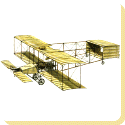 Henry Farman III Biplane — The Farman III, also known as Henry Farman 1909 biplane, was an early French pusher biplane, designed and built by Henry Farman in 1909, and considered a significant step in the history of aviation.
Henry Farman III Biplane — The Farman III, also known as Henry Farman 1909 biplane, was an early French pusher biplane, designed and built by Henry Farman in 1909, and considered a significant step in the history of aviation.
Design & Development
Henry Farman’s first aircraft had been bought from the Voisin brothers in 1907. Soon after his first flights Farman begun to modify and improve the design of the aircraft which was known as either the Farman I or Voisin-Farman I. During 1908 Farman re-covered the aircraft with ‘Continental’ rubberized fabric and added the side curtains and it was re-designated the Farman I-bis. During 1908 the Voisin brothers built him another aircraft, to be called the Farman II, incorporating refinements of the design to Farman’s specification. However, Voisin sold this aircraft to J.T.C. Moore-Brabazon. Brabazon subsequently exported the aircraft to England, where it became known as the Bird of Passage.
This episode naturally angered Farman, and caused him to break his association with Voisin in early 1909 and start aircraft construction for himself, as he designed and built the Farman III. The Farman III was also a pusher biplane with a single forward elevator and originally had a cellular tail plane and ailerons on all four wings. It first flew in April 1909 powered by a 50 hp (37 kW) Vivinus 4-cylinder inline engine. Farman soon introduced an open tail plane with trailing rudders and an extended span upper wing and a light weight four wheel landing gear. Farman also replaced the engine with the new and more reliable 50 hp (37 kW) Gnome rotary engine.
The Farman III had enormous influence on European aircraft design, especially in England. Drawings and details of the aircraft were published in England by Flight magazine and it was so widely imitated that its layout became referred to as the “Farman Type”. Among these aircraft are the Bristol Boxkite, the Short S.27 and the Howard Wright 1910 Biplane. The Bristol aircraft was so close to Farman’s design that he considered legal action. Farman was rewarded by commercial success, and many examples of the type were sold.
In late 1909, Henry Farman established two world distance records with flights of 180 km (110 mi) in just under 3 hours 5 minutes at Rheims on August 27 and 232 km (144 mi) in 4 hours 17 minutes and 53 seconds at Mourmelon on November 3.
Henry Farman’s brother, Maurice Farman, constructed his own biplane slightly earlier in 1909. It first flew in February 1909. Both machines were derived from the Voisin 1907 biplane, all having similar configurations. Henry’s aircraft differed from Maurice’s in lacking the pilot’s nacelle, and not using Renault inline engine. Maurice and Henry started close collaboration in 1912.
 Kids Portal For Parents India Kids Network
Kids Portal For Parents India Kids Network
